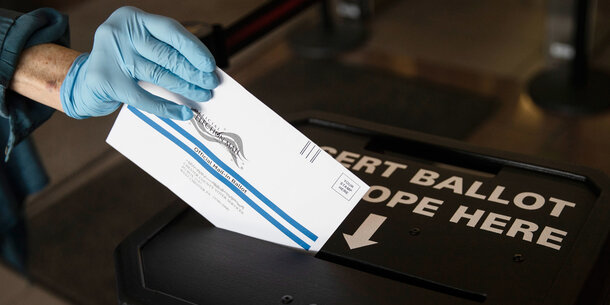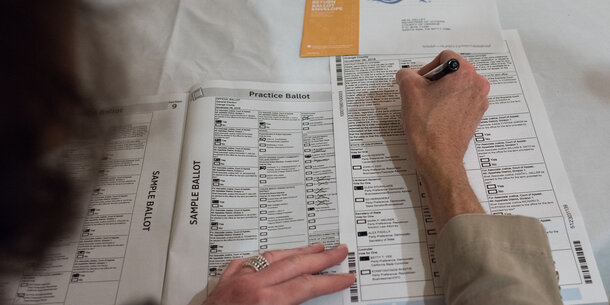With unprecedented numbers of Americans expected to use mail ballots this year, the U.S. Postal Service will be an essential part of ensuring that the election is safe and fair. But the agency is facing a funding crisis, staffing overhauls, and severe cost-cutting measures.
There have been delays, interruptions in services, and reports of mailboxes being removed and bulk mail sorting machines being deactivated. With the Covid-19 pandemic surging in many parts of the country and a high-stakes election coming up, there are growing concerns about whether the Postal Service’s ability to deliver mail ballots on time is being sabotaged by the Trump administration. The postmaster general has said he will delay some of the changes underway, but uncertainties remain.
How does the USPS work?
The U.S. Postal Service is an independent government agency rooted in the principle that every person in the country “has the right to equal access to secure, efficient, and affordable mail service.” The agency employs nearly half a million career employees and has a very diverse workforce — 39 percent of its employees are people of color, including 21 percent who are Black. The agency also employs nearly 100,000 military members and veterans.
Americans rely on the Postal Service for delivery of bills and essential documents, medications, and voting ballots. Such services are particularly important for small businesses, as well as people in rural areas, senior citizens, indigenous people, and those with disabilities, as they may not be able to access or afford private shipping companies.
The Postal Service does not get taxpayer money, but relies on revenues from sales of postage, products, and services. As a public utility, it is charged with providing regular services in every area, no matter how far-flung or costly. It consistently ranks among the most favorable of government agencies, with 91 percent of Americans reporting a positive opinion.
Why is the USPS short of funds?
The USPS is facing a funding crisis because of years of declines in use of postal services, which has been compounded by an additional drop in usage because of Covid-19, as well as the longstanding impact of federal legislation.
A 2006 law, the Postal Accountability and Enhancement Act, was especially harmful. It required the agency to fund all retirement and health benefits in advance instead of using a pay-as-you-go system, doubling its annual net losses to $8.8 billion last year. No other federal agency is subject to such a mandate. Without it, the Postal Service would have been profitable for the last six years.
President Trump has been a frequent critic of the USPS, calling for service cuts and refusing to bail out the agency during the pandemic, even as its workers risk exposure to the coronavirus while serving the public. He acknowledged that he opposes funding because he wants to make it harder for people to vote by mail — even though he requested a mail-in ballot for himself as recently as August to vote in Florida’s primary.
What are the recent developments with the USPS?
Concerns about targeting the USPS have amplified since June, when Louis DeJoy, an ally of President Trump and a major Republican donor, took over as postmaster general. DeJoy has never worked in a post office before and has significant financial holdings in a company that the Postal Service contracts with for help during busy periods. He has restructured the organization and instituted cost-cutting measures, reassigning or displacing 23 postal executives in August.
There are reports of the USPS drastically cutting overtime hours, instructing postal workers to leave mail behind if it leads to delays, and instituting a hiring freeze. Businesses and residents have faced delays and interruptions from an agency with a longstanding record of delivering on time.
With the election just months away, it has been reported the USPS is removing mailboxes, deactivating mail sorting machines, and slashing its opening hours by more than a half in some locations, including during the busiest times of the day.
And in a departure from a longstanding informal practice of postal workers treating election-related mail as first class even when it is sent using a cheaper bulk mail rate, the agency is now warning states that they should pay the higher rate to ensure they are classified as first class mail and delivered more quickly. This could present a major financial challenge for many struggling governments, particularly given the expected increases in mail-in ballot requests and the budgetary shortfalls due to the pandemic.
Lawmakers from both parties have called for changes that have disrupted services to be reversed and sounded alarms about them taking place ahead of an election. Facing intense criticism, Postmaster General Louis DeJoy announced on August 18 that he is “suspending” some of the changes until after the election, but it’s not clear if changes that have already been made, like the removal of mailboxes and sorting machines, will be reversed.
The House is scheduled to return from its August break on Saturday to vote on emergency legislation to fund the Postal Service with a $25 billion grant and block changes that have slowed down services. DeJoy is scheduled to testify in front of an urgent House Oversight Committee hearing on August 24.
How could this impact the election?
The pandemic has prompted record numbers of voters to request mail ballots in recent elections, and these numbers are likely to swell leading up to November. With coronavirus cases surging in parts of the country, many voters may be ill or worried about voting in person. An estimated 80 million mail ballots could be cast, which would be double the number in 2016.
The Postal Service recently warned 46 states and the District of Columbia that it cannot guarantee all mail-in and absentee ballots will arrive in time to be counted, which means that many voters would be disenfranchised. In this year’s primaries, that happened to at least 65,000 people.
Voting by mail is a safe, secure, and an increasingly popular way to cast a ballot, and the only way for some Americans to exercise this constitutional right. Citizens in some rural areas can only vote by mail because they do not have voting precincts. For many seniors, disabled residents, and indigenous people living on remote tribal land, it is the only feasible way to have their say in elections.
Using private companies such as UPS and FedEx is not possible in most states because various laws and regulations require a postmark that can only be made by the USPS, and there are prohibitions against private parties collecting and delivering ballots. Further, using the companies would be prohibitively expensive for many states as well as voters. For example, a FedEx envelope costs at least $8.50, which is more than 15 times the Postal Service’s typical fee of 55 cents. Reliance on private companies would leave many voters disenfranchised, since unlike the Postal Service, they are not required to be everywhere.
What can be done to protect Americans’ ability to use mail ballots?
This is not the time to slash costs and overhaul the Postal Service — the agency should be adequately funded and staffed to ensure it can handle an anticipated spike in mail ballots during a key election taking place in a pandemic.
The USPS ought to do everything it can to ensure that election materials are delivered before deadlines. That means immediately restoring overtime policies, going back to prioritizing mail ballots, and working with election officials to understand their requirements in order to protect Americans’ right to vote.
To help give the USPS ample time to deliver all mail ballots, citizens voting by mail can do their part by requesting absentee or mail ballots as soon as possible and either dropping them off in designated locations or mailing them well ahead of Election Day.
And elected leaders, instead of financially starving the USPS and undermining its ability to do its critical job, need to fund the agency and support its vital role of helping Americans exercise their right to vote.


